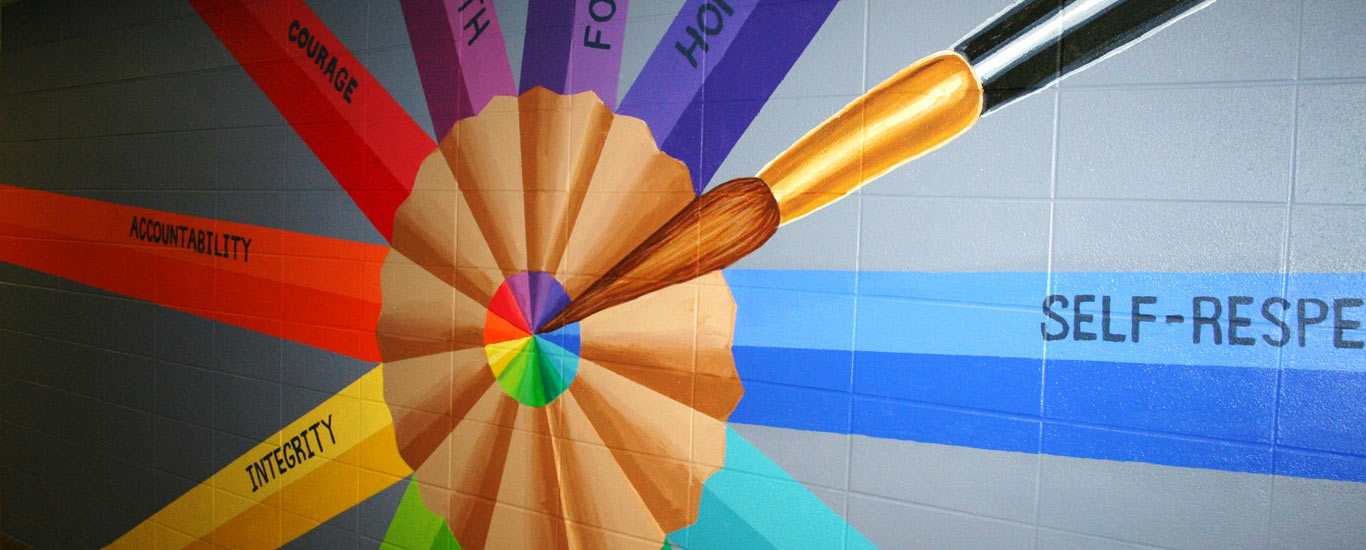Research shows that art enables youthful offenders to release inner feelings and talk about issues pertinent to them. Given these initial benefits, future study will allow the Emanuel Project Research Team to determine empirically if participation in the Emanuel Project, and/or art therapy in curriculum and instruction truly make a difference in self-image, perception and/or reduced challenges for at-risk youth.
Case Example:
Noah was angry at the world and had shut himself off from everyone at the facility. One day the counselor, after several attempts to talk to Noah, gave him some colored pencils and a piece of paper and told him to draw his life story. As Noah began to draw, guns and other images appeared that painted a dark past.
The counselor then began to ask about some of the various images Noah had drawn. Slowly he began to open up and explain the images and his traumatic past. The door of communication between Noah and his counselor was opened allowing the counselor to help Noah deal with some of the issues of his past because he was able to express his emotion and pain through art.
Youth are faced with a myriad of environments that impact decision-making and self-esteem. Some youth face obstacles by acting out while others shut down. Noah is one example of a youth that completely shut down. Noah was angry at the world and had shut himself off from everyone at the facility, refusing to talk about his past. One day, the counselor gave Noah some colored pencils and a piece of paper and asked him to draw his life story. As Noah began to draw guns and other images that painted a dark past, the counselor began asking Noah about the images. Slowly, Noah began to open the door of communication and explain the images and his traumatic past. This allowed the counselor to help Noah deal with some of the issues of his past because he was finally able to express his emotion and pain. Noah was able to do this through art.
The Emanuel Project benefits the students and teachers by enhancing the existing curriculum with art projects, supplies, and ideas that will provide a more engaging and inspiring learning environment for students. The Emanuel Project benefits each facility by working with them to create “Murals of Hope” that enable youth who participate to earn a sense of pride and ownership. In (2011), 200 residents at five (5) separate facilities in Colorado, Georgia, and Tennessee were assessed before and after the implementation of the Emanuel Project. Several positive outcomes were discovered: (1) confidence to complete school work increased 8.5%; (2) self-esteem increased 14.8%; (3) 88% of the students reported that it helped their self-esteem and self-worth; and (4) content comprehension increased 8.5%. Educators within these facilities also noticed a difference in the youth that participated in the Emanuel Project. In this same study, 26 educators at the Georgia and Colorado facilities were assessed before and after the implementation of the Emanuel Project at their facility. The results indicated that (1) student understanding of course content increased 13% and (2) 83% of teachers felt like students participated better in group activities as a result of the Emanuel Project.
Additionally, behavior is also improved by incorporating art into the curriculum. The Muscogee Youth Detention Center (YDC) in Columbus, Georgia averaged 16-20 incidents per month before the Emanuel Project. During the Emanuel Project, there was only one (1) reported incident. Similarly, in the girl’s facility, there were no reported behavioral incidents while working with Emanuel. The Morehead YDC in Morehead, Kentucky reported similar results. Four (4) months prior to the implementation of the Emanuel Project, youth spent an average of just over 173 hours a month in isolation as opposed to only six (6) hours per month in isolation four (4) months after the implementation of the Emanuel Project. They also saw a drop in incidents of 50%. Therefore, both the youth and educator surveys indicate that there are some positive trends in self-esteem, academics, and behavior.
The need to expand this research is imperative to the well-being of youth, especially those who have been incarcerated at a YDC. The Emanuel Project is working to collect data in areas such as self-esteem, number of hours in isolation, behavior and incident reports, number of students sent out of class at specific time intervals, GED scores, TABE scores, reading scores, number of units completed, attitudes toward art from both student and teacher perspectives, and recidivism. This information is collected through stories, testimonials, case studies, pre- and post-test surveys, as well as the collection of existing data. Future studies will provide a larger participant population from which we can evaluate the effectiveness of extended exposure to the Emanuel Project in order to improve both short-term and long-term outcomes for youth.
